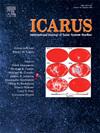How much earlier would LSST have discovered currently known long-period comets?
IF 2.5
2区 物理与天体物理
Q2 ASTRONOMY & ASTROPHYSICS
引用次数: 0
Abstract
Among solar system objects, comets coming from the Oort Cloud are an elusive population, intrinsically rare and difficult to detect. Nonetheless, as the more pristine objects we can observe, they encapsulate critical cues on the formation of planetary systems and are the focus of many scientific investigations and science missions. The Legacy Survey of Space and Time (LSST), which will start to operate from the Vera C. Rubin Observatory in 2025, is expected to dramatically improve our detection ability of these comets by performing regular monitoring of the Southern sky deep down to magnitude 24.5 with excellent astrometry. However, making straightforward predictions on future LSST detection rates is challenging due to our biased knowledge of the underlying population. This is because identifications to date have been conducted by various surveys or individual observers, often without detailed information on their respective selection functions. Recent efforts (see e.g. Vokrouhlickỳ et al., 2019) to predict incoming flux of Long Period Comets still suffer of the lack of systematic, well-characterized, homogeneous cometary surveys. Here, we adopt a different point of view by asking how much earlier on known comets on long-period or hyperbolic orbits would have been discovered by a LSST-like survey if it was already in place 10 years prior to their perihelion epoch. In this case, we are not simulating a real flux of incoming comet, as all comets in our sample reach the perihelion simultaneously, but we can analyze the impact of a LSST-like survey on individual objects. We find that LSST would have found about 40% of comets in our sample at least 5 years prior to their perihelion epoch, and at double (at least) the distance at which they were actually discovered. Based on this approach, we find that LSST has the potentiality to at least twofold the current discovery rate of long-period and hyperbolic comets.
求助全文
约1分钟内获得全文
求助全文
来源期刊

Icarus
地学天文-天文与天体物理
CiteScore
6.30
自引率
18.80%
发文量
356
审稿时长
2-4 weeks
期刊介绍:
Icarus is devoted to the publication of original contributions in the field of Solar System studies. Manuscripts reporting the results of new research - observational, experimental, or theoretical - concerning the astronomy, geology, meteorology, physics, chemistry, biology, and other scientific aspects of our Solar System or extrasolar systems are welcome. The journal generally does not publish papers devoted exclusively to the Sun, the Earth, celestial mechanics, meteoritics, or astrophysics. Icarus does not publish papers that provide "improved" versions of Bode''s law, or other numerical relations, without a sound physical basis. Icarus does not publish meeting announcements or general notices. Reviews, historical papers, and manuscripts describing spacecraft instrumentation may be considered, but only with prior approval of the editor. An entire issue of the journal is occasionally devoted to a single subject, usually arising from a conference on the same topic. The language of publication is English. American or British usage is accepted, but not a mixture of these.
 求助内容:
求助内容: 应助结果提醒方式:
应助结果提醒方式:


